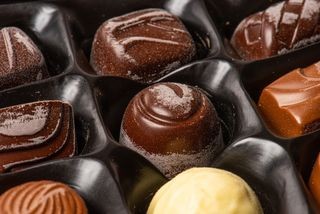(Image credit: Trygve Finkelsen via Getty Images)
That disappointing white film on your favorite milk chocolate bar isn’t mold. It’s a natural phenomenon called “chocolate bloom.” While unsightly, it’s perfectly safe to eat. This article explores the science behind why milk chocolate turns white and what you can do about it.
Understanding Chocolate Bloom
Chocolate bloom occurs when fat or sugar molecules within the chocolate separate and rise to the surface. There are two primary types: fat bloom and sugar bloom. Let’s delve into each:
Fat Bloom: The Cocoa Butter Culprit
Fat bloom, appearing as a white sheen or blotchy white spots, happens when cocoa butter, the natural fat in chocolate, migrates to the surface. Several factors contribute to this migration:
- Temperature Fluctuations: Changes in temperature, especially warm storage conditions, can cause the cocoa butter to melt and recrystallize on the surface.
- Improper Storage: Exposure to light and improper handling can also accelerate fat bloom.
- Cocoa Butter Composition: The type and quality of cocoa butter used in chocolate production can influence its susceptibility to blooming.
(Image credit: nbehmans via Getty Images)
Sugar Bloom: Moisture’s Mischief
Sugar bloom, characterized by a rough, gritty texture and a finely speckled appearance, results from moisture on the chocolate’s surface. This occurs when:
- Chocolate is Stored in Humid Environments: Moisture dissolves the sugar crystals on the chocolate’s surface, which then recrystallize as a white film when the moisture evaporates.
- Condensation Forms: Bringing cold chocolate into a warm, humid environment can cause condensation, leading to sugar bloom.
The Science of Chocolate Making and Bloom
Understanding how chocolate is made provides further insight into why bloom happens. Chocolate production involves several steps, from fermenting and roasting cacao beans to grinding them into a paste called cocoa mass or chocolate liquor.
- Cocoa Butter vs. Cocoa Fiber: Cacao beans contain roughly equal parts cocoa butter (the fat) and cocoa fiber (the solid). Cocoa butter gives chocolate its melt-in-your-mouth texture, while cocoa fiber contributes to color and flavor.
- Tempering’s Role: Chocolatiers use a process called tempering, carefully heating and cooling liquid chocolate, to ensure the cocoa butter crystallizes in a stable form. This creates a smooth, glossy finish and prevents bloom. However, temperature fluctuations after tempering can disrupt this crystalline structure, leading to bloom.
Can You Still Eat White Chocolate Bloom?
Yes, chocolate with bloom is safe to eat. It might have a slightly less appealing texture or a duller flavor, but it poses no health risks.
Preventing and Reversing Chocolate Bloom
While bloom is a natural process, you can take steps to minimize its occurrence:
- Proper Storage: Store chocolate in a cool, dry, and dark place with a stable temperature. Avoid fluctuating temperatures and direct sunlight.
- Careful Handling: Avoid touching chocolate with warm hands, as this can accelerate fat bloom.
- Tempering Techniques: For homemade chocolate, ensure proper tempering techniques are followed.
Although preventing bloom entirely is challenging, you can sometimes reverse it. Gently melting and re-tempering the chocolate can restore its original texture and appearance. Bloomed chocolate is also perfectly fine for use in baking or making hot chocolate.
Conclusion
White chocolate bloom, while aesthetically unpleasing, is a natural and harmless occurrence. Understanding the science behind bloom empowers consumers to store their chocolate properly and potentially even reverse the process. So, the next time you encounter a white-spotted chocolate bar, don’t despair – it’s still likely delicious!

